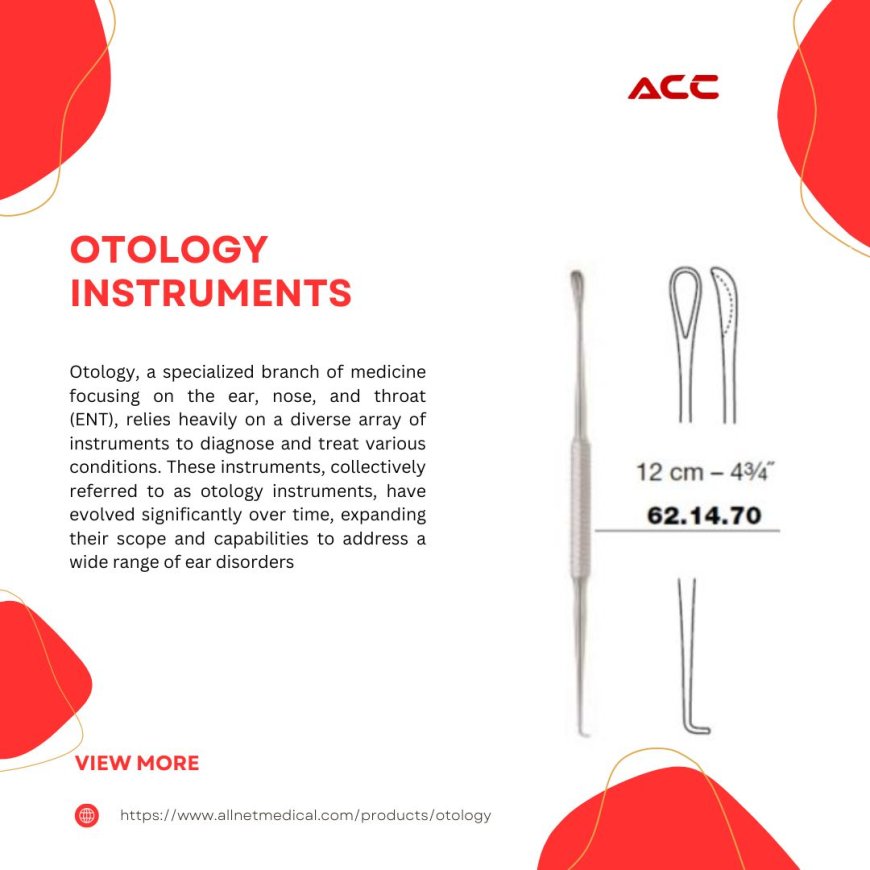Types of Otology Instruments: Essential Tools in ENT Otology
In the field of ENT otology, specialized tools known as otology instruments are used for diagnosing, treating, and managing ear-related conditions

Types of Otology Instruments: Essential Tools in ENT Otology
In the field of ENT otology, specialized tools known as otology instruments are used for diagnosing, treating, and managing ear-related conditions. These otology tools play a crucial role in maintaining and restoring ear health, from routine check-ups to complex surgeries. In this article, we will explore the various types of otology instruments, their applications, and how they contribute to effective ear care.
1. Diagnostic Otology Instruments
Accurate diagnosis is the first step in treating any ear-related condition. Diagnostic otology instruments allow healthcare professionals to examine the ear and assess any abnormalities.
Otoscopes
The otoscope is one of the most commonly used tools in ENT otology. This handheld device is designed to look inside the ear canal and visualize the eardrum. It is essential for detecting infections, blockages, and other conditions. Otoscopes come with a magnifying lens and a light source, allowing specialists to examine the ear in detail.
Audiometers
Audiometers are used to evaluate a patient’s hearing capacity. This otology tool measures the ability to hear sounds of varying frequencies and intensities. Audiometry is critical for diagnosing hearing loss and is often used in routine hearing tests or to assess hearing function before and after treatments or surgeries.
Tympanometers
Tympanometers measure the pressure in the middle ear and the movement of the eardrum. These otology instruments help diagnose conditions like fluid buildup, eustachian tube dysfunction, or middle ear infections. Tympanometry provides valuable information about the middle ear’s health and its ability to transmit sound.
2. Surgical Otology Instruments
When ear conditions require surgical intervention, specialized otology tools enable ENT professionals to perform precise procedures. These instruments are designed to work in the small and delicate structures of the ear, making them vital in otology surgery.
Ear Specula
Ear specula are small, conical tools used in conjunction with an otoscope or a surgical microscope. These otology instruments help widen the ear canal, providing a clearer view for the surgeon or specialist. They are essential in both diagnostics and surgeries, particularly when accessing deeper areas of the ear.
Micro Scissors and Forceps
Microsurgical scissors and forceps are vital in delicate ear surgeries. These otology tools allow surgeons to cut or grasp tissues with extreme precision. They are commonly used in procedures like tympanoplasty (eardrum repair) or stapedectomy (middle ear surgery), where accuracy is crucial to success.
Ear Drills
Ear drills are used in more complex surgeries, such as mastoidectomy, where infected or damaged bone is removed from the ear. These otology instruments are specially designed to drill into the tiny bones of the ear without damaging surrounding tissue. Surgeons use them to create access points and remove damaged tissue, ensuring that the ear remains functional.
Endoscopes
Endoscopes are advanced otology tools that allow surgeons to perform minimally invasive surgeries. These thin, flexible instruments have a light and camera attached, providing real-time images of the ear’s interior during surgery. Endoscopes are often used in procedures like cholesteatoma removal, where visibility is key to success.
Laser Instruments
Laser technology is increasingly used in ENT otology surgeries for its precision and minimal invasiveness. Laser otology tools help in cutting or vaporizing tissues, reducing bleeding and tissue damage. Lasers are commonly used in cochlear implant surgeries and other procedures that require high accuracy.
3. Therapeutic Otology Instruments
Beyond diagnostics and surgery, otology tools are also used for therapeutic treatments, helping patients manage chronic ear conditions and improve their hearing.
Cochlear Implant Devices
Cochlear implants are advanced hearing devices used for patients with severe hearing loss. Implantation requires the use of specific otology instruments to precisely place the device within the cochlea. Cochlear implants work by bypassing damaged parts of the ear and directly stimulating the auditory nerve, restoring the sense of sound.
Hearing Aid Fitting Tools
Hearing aids are custom-fitted devices that help patients with hearing impairments. Otology tools like ear impression kits are used to create molds of a patient’s ear, ensuring that the hearing aid fits comfortably and functions effectively. Proper fitting ensures the device’s long-term success and comfort for the patient.
Earwax Removal Tools
In cases of excessive earwax buildup, which can lead to infections or hearing loss, ENT specialists use tools like curettes or suction devices. These otology instruments help safely remove earwax from the ear canal without causing injury or discomfort.
4. Endoscopic and Minimally Invasive Otology Instruments
With the rise of minimally invasive techniques in medicine, otology tools such as endoscopes and lasers have become integral to modern ear care.
Endoscopes for Diagnostic and Surgical Use
Endoscopic otology tools are used for both diagnostics and surgeries. In diagnostics, they help visualize the ear’s internal structures, while in surgery, they allow for precision without the need for large incisions. Endoscopic ear surgeries are becoming more popular due to their minimally invasive nature, shorter recovery times, and reduced risk of complications.
Laser Otology Tools
Lasers are increasingly used in otology for various surgical procedures. Laser otology tools offer extreme precision, reduced bleeding, and faster healing. In procedures like stapedectomy or cochlear implantation, lasers allow surgeons to operate on the tiny structures of the ear with greater control and less trauma to surrounding tissues.
Conclusion
The wide range of otology instruments available today allows ENT specialists to provide comprehensive care for ear-related conditions. Whether diagnosing hearing loss with audiometers or performing delicate surgeries with endoscopic tools, these otology tools are essential for improving patient outcomes in ENT otology. As technology continues to advance, the types of instruments used in otology will only become more sophisticated, enabling even greater precision and success in ear care. For more information: Allnet
What's Your Reaction?

























